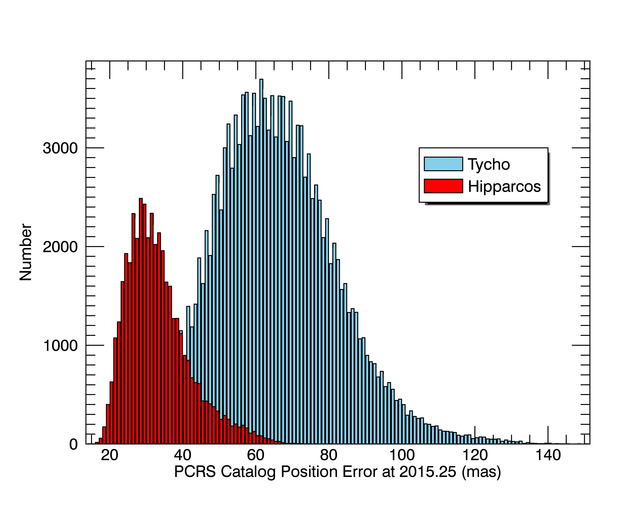IRAC High Precision Photometry
Where possible, observers should use PCRS peakup on their target itself.
Outside of the V = 7 - 12.1 mag range, or if the target star has a V < 13mag neighbor within 40 arcseconds, catalog stars must be used for PCRS peakup due to the sensitivity of the PCRS detector. The PCRS catalog was generated in an automated way using Tycho1&2 and Hipparcos as the basis, with cuts for quoted position errors, neighboring objects, background variation, as well as stellar magnitude, color, and variability. It is expected that less than 5% are bad. A description of the catalog can be found here. The distribution of position errors for the entire catalog for an epoch of 2015.25 is shown below, color coded by source of the proper motion value.
Proper motion errors are the largest source of position errors. Observers should consider both the position errors of their targets as well as the PCRS catalog star in use. The goal in choosing a catalog star is to have a combined error on the position of the catalog star plus the position of the target star which is small compared to the width of the sweet spot (0.35arcsec). In order to choose the best possible catalog star, the SSC provided code, pick_pcrs_catalog.pro, provides information on the position errors and distance to the catalog star when used in conjunction with Spot.
If the proper motion errors on either your target or available catalog stars are too large, we recommend doing PCRS-peakup observations of the catalog star + target to derive individual offsets for that particular star pair. We recommend doing 6 sample AORs of 10 repeats each to build up statistics on those offsets. Each AOR should be a peakup AOR on the exact catalog star planned for use in the science AORs. You will then be able to transform the actual measured positions of where the target falls on the pixel in the pre-obs frames to a cluster offset in the target definition for future AORs which will shift the target onto the sweet spot. Contact the SSC helpdesk for the transformation equations.
In the case of stars closer than 25pc, position shifts due to parallax must be calculated and included in the target offsets. Spot does not have a specific way to enter parallax itself. The best practice for deciding if your target needs a parallax correction is to use the SSC provided code, make_parralax_coords to determine what the maximum change in position would be for observations taken at different times during the year. If that maximum change is 0.1 arc seconds or greater, please contact the SSC Helpdesk to make sure your AORs include this change in position for the exact epoch that your target will be observed.
A copy of the PCRS peakup catalog is available with the pick_pcrs_catalog.pro code.

PCRS Catalog position errors for all catalog stars color coded by origin catalog